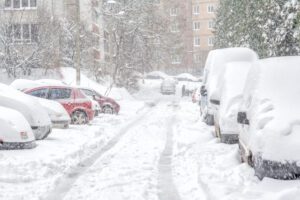In 2016, the city of Las Vegas announced that it had reached its goal of powering the city government entirely with renewable energy. This goal was reached with the launch of Boulder Solar 1, a 100-megawatt solar plant located just south of the city. Las Vegas began its renewable energy project in 2008, reducing electricity usage through sustainability programs and installing solar panels on city buildings. These sustainability efforts have reduced the city’s electricity usage by more than 30%, saving the city approximately $5 million a year.
This announcement led to some confusion as several media outlets ran the story that the entire city of Las Vegas was being powered by 100% renewable energy and not just the city government. As it turns out, in 2016, a vast majority of the state of Nevada and Las Vegas as a whole were powered by natural gas.
Where does Las Vegas’s Renewable Energy come from?
There are two main sources of renewable energy for Las Vegas. The first is solar and the second is hydro. The deserts surrounding Las Vegas have been a hot bed for giant solar plants and three major plants power Las Vegas. In 2014, the Ivanpah Solar Electric Generating System opened at the base of Clark Mountain in California just across the border from Nevada. When it opened it was the world’s largest solar thermal power station at 3,500 acres with a gross capacity of 392 megawatts. However, this plant is not entirely renewable as the plant burns natural gas each morning to start the operation.
About 190 miles northwest of Las Vegas the Crescent Dunes Solar thermal power project is located. This power plant uses mirrors to collect and focus the sun’s thermal energy to heat molten salt flowing through a central 656-foot-tall tower. This plant has a capacity of 110 megawatts with an ability to store 1.1 gigawatt-hours of energy storage. This plant was shut down in April of 2019 but restarted production in 2021.
The last solar plant, the Gemini project, is located about 30 minutes outside of Las Vegas. This plant, which was commissioned in 2023, is capable of producing 690 megawatts. Gemini has deployed nearly 1.8 million shingled bifacial photovoltaic modules that use high-efficiency mono-PERC solar cells. This plant will provide power for up to 260,000 homes when running at its peak. All of this solar energy has led to Las Vegas being named a “Solar Superstar” by the Environment Nevada Research & Policy Center’s report. They found that Las Vegas ranked second in the U.S. for installed solar Photovoltaic capacity per capita amongst major U.S. cities.
The Hoover Dam
Las Vegas’s hydro power comes from the electricity generated at the Hoover Dam, located about 30 miles southeast of Las Vegas. The Hoover Dam was constructed in the 1930s in the Black Canyon of the Colorado River on the Nevada/Arizona state border. The Hoover Dam is 726.4 feet tall, 1,244 feet long, and 45 feet wide. 3,250,000 cubic yards of concrete was used to create the giant dam. The Dam was named after then President Herbert Hoover but was temporarily renamed the Boulder Dam by the Roosevelt administration. This name was after the Boulder Canyon that sits above the dam and was flooded to create Lake Mead. After Roosevelt’s death the dam’s name was changed back to Hoover.
It took 5 years, over 5,000 workers and cost $49 million to build the dam, that is $763 million in 2022 dollars. The construction had several issues that plagued them during the build. The summer of 1931 was an especially hot one with daytime highs averaging 119.9°F. Sixteen workers died from the heat that June and July. A total of 112 official fatalities occurred during construction with more occurring due to pneumonia that had spread throughout the workers.
The Hoover Dam was built to control the water flow of the Colorado River and to generate electric power. Controlling the Colorado River can prevent flooding downstream which allowed for modern agriculture techniques to be used downstream in California.
Power From the Hoover Dam
In 1936, the Hoover Dam turned on its first three turbine-generators. By 1939, nine generators were operating, and the plant had become the largest hydroelectric facility in the world. The final of the 17 generators was placed into service in 1961. Before water reaches the turbines, it enters intake towers that gradually narrow creating water pressure that pushes the water through the turbines at 85 mph. The entire flow of the Colorado River usually passes through the turbines. The annual electric generation of the Hoover Dam varies with the maximum net generation being 10.348 terawatts/hour in 1984 and the minimum being 2.648 terawatts/hour in 1956. The amount of electricity generated by the Hoover Dam has been decreasing due to the falling water level in Lake Mead. By 2014 the dam’s generating capacity was downrated by 23% due to the drop in water.
Not all of Hoover Dam’s energy goes to Las Vegas. Only 25.2% of the power goes to Nevada with another 19% going to Arizona. The rest goes to California with a majority of that going to the Metropolitan Water District of Southern California.
Lake Mead’s Falling Water Levels
Since the year 2000, a prolonged drought combined with high demand for the Colorado River’s water has led to a decline in the water level at Lake Mead. In June of 2010, the lake was at 39% of its capacity. Following this, the Colorado River Basin suffered its worst consecutive water years on record in 2012 and 2013. In 2015 and 2016 the water dropped below the 1,075-foot line to trigger the drought restrictions. These were short lived as a larger than normal snowmelt in 2017 pushed the water levels safely above drought conditions. This lasted until June of 2021 when the water levels dropped below the drought levels and continued to fall until July of 2022 where they hit the lowest levels, 1,040 feet, since 1937 when the reservoir was initially filled. This has since rebounded in 2023 with the average water level being above 1,060 feet for the second half of the year. This means that drought restrictions are still in place and have been for multiple years now.
The Dam can continue normal power production until Lake Mead drops to 950 feet and even then, the dam can still generate power but the turbines that have not been upgraded will be operating in the “rough” zone. Due in part to the fear of further drops in Lake Mead’s water level Nevada approved a $333 million natural gas plant in 2023. This will be built north of Las Vegas and will be operational by July 2024. This is the first new natural gas plant in the state in over a decade and jeopardizes the state’s commitment to be a carbon-free power grid by 2050.
A Balancing Act
Solar and hydro have proven effective and shown promise towards Nevada’s carbon-free power goals. Balancing current power requirements and future power objectives is a tricky one. Using a new natural gas plant seems contrary to these goals, but what is one to do if Lake Mead dries up? The path is never a straight line.
What are your carbon-free goals? Give us a call and we will plan the future together.





